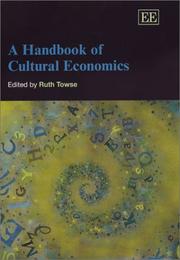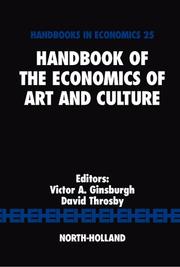| Listing 1 - 7 of 7 |
Sort by
|

ISBN: 0415044502 Year: 1990 Publisher: London Routledge
Abstract | Keywords | Export | Availability | Bookmark
 Loading...
Loading...Choose an application
- Reference Manager
- EndNote
- RefWorks (Direct export to RefWorks)
Art --- Organization theory --- Sociology of cultural policy --- Economie de la culture --- Industrie culturelle
Book
ISBN: 2111399159 Year: 2015 Publisher: Paris : Département des études, de la prospective et des statistiques,
Abstract | Keywords | Export | Availability | Bookmark
 Loading...
Loading...Choose an application
- Reference Manager
- EndNote
- RefWorks (Direct export to RefWorks)
What is a collector? Although the French term collectionneur was first officially recorded in the dictionary in 1789*, its definition covers a range of different practices: for some, the main emphasis is on an item's subjective value, whilst others focus more closely on the accumulation and selection process. Whether they collect shells, stamps, butterflies or works of art, collectors share a number of things in common. However, those who support “emerging” art have a more varied set of practices than those generally observed in their counterparts. In addition to simply being a buyer, the contemporary art collector has the ability to influence the artistic life, especially through the material support provided to artists and by contributing to the construction of artistic value. This particular characteristic is all the more notable as the collector's involvement in artistic life is not solely the prerogative of a narrow wealthy elite, as the collector profiles here demonstrate. Indeed it seems that collector practices may fall anywhere across a scale which ranges from the acquisitive collector, motivated by the desire to possess a work, to the actor collector, for whom the actual acquisition of a work is merely the expression of his willingness to contribute to the vitality of the artistic scene. * « Collector, -s (n). One who collects. Collection, -s (n). A number of objects gathered together under a common theme. A beautiful collection of paintings, books, antiques, medals, plants, shells, etc. » Dictionnaire de l’Académie française, 1789 (7th edition). Qu’est-ce qu’un collectionneur ? Si le nom a fait officiellement son entrée dans le dictionnaire en 1789*, sa définition recouvre des pratiques différentes : certaines approches mettent en avant la valeur subjective attachée à l’objet, tandis que d’autres soulignent l’importance du processus d’accumulation et de sélection. De nombreux traits semblent pouvoir définir communément les collectionneurs, quel que…
Art --- Business --- art contemporain --- collectionneur --- économie de la culture et de la communication --- contemporary art --- collector --- economics of culture and Communication

ISBN: 1840643382 9781840643381 1845422341 9781845422349 Year: 2003 Publisher: Cheltenham Elgar
Abstract | Keywords | Export | Availability | Bookmark
 Loading...
Loading...Choose an application
- Reference Manager
- EndNote
- RefWorks (Direct export to RefWorks)
bedrijfsbeleid --- kunst --- Art --- Business policy --- Service industry --- Arts --- Economic aspects --- AA / International- internationaal --- 339.325.6 --- Culturele behoeften. --- Economic aspects. --- Culturele behoeften --- Arts - Economic aspects --- Économie de la culture --- Industries culturelles --- Aspect économique
Book
ISBN: 211139923X Year: 2014 Publisher: Paris : Département des études, de la prospective et des statistiques,
Abstract | Keywords | Export | Availability | Bookmark
 Loading...
Loading...Choose an application
- Reference Manager
- EndNote
- RefWorks (Direct export to RefWorks)
In 2011, cultural industries had a total production of 85 billion euros with an added value of 40 billion euros. Cultural production is divided and shared between a merchantable amount of 69 billion euros from the sale of companies’ cultural goods and services, and a non-merchantable amount of 16 billion euros, which corresponds, by convention, to the production costs of departments, public institutions and associations in the cultural sector. The direct economic impact of culture, measured as the relationship between the added value of cultural industries and that of all industries, was 2.2% in 2011. It did not take into account the indirect or induced economic benefits resulting from culture (tourism, for example). Until 2003, the direct economic impact developing the value of culture has increased. However, it has been falling since 2004, which is mainly attributed to the marked decline in activity in certain cultural industries (publishing, the press, record). In 2011, the audio-visual industry (radio, cinema, television, video, record) contributed to one quarter of added cultural value. The performing arts and heritage, predominantly non-merchantable industries, contributed to 18% and 11% of added value respectively. The progress made during the last fifteen years in the share price in terms of value of the performing arts is mainly down to the rising prices in this industry. In contrast, books and the press only contributed to 15% of added cultural value in 2011, versus 26% in 1995. Other cultural industries (advertising agencies, architecture, the visual arts, cultural education) contributed, as a whole, to one third of added cultural value. En 2011, les branches culturelles totalisent une production de 85 milliards d’euros et une valeur ajoutée de 40 milliards d’euros. La production culturelle se partage entre une partie marchande (69 milliards d’euros), issue de la vente des biens et services culturels des entreprises, et une partie non marchande (16…
Cultural studies --- Economics (General) --- économie de la culture et de la communication --- emploi culturel --- politiques publiques --- statistiques culturelles --- INSEE --- economics of culture and Communication --- INSEE (National Institute of statistics and economic studies) --- cultural employment --- cultural statistics
Book
ISBN: 9780415882736 9780415810999 0415882737 9780203832097 9781136833878 9781136833915 9781136833922 041581099X 1136833919 9786613040879 0203832094 1136833927 1283040875 Year: 2011 Volume: 33 Publisher: New York London : Routledge,
Abstract | Keywords | Export | Availability | Bookmark
 Loading...
Loading...Choose an application
- Reference Manager
- EndNote
- RefWorks (Direct export to RefWorks)
Carrigan here examines the aesthetic portrayal of tourism in postcolonial literatures. Looking at the cultural and ecological effects of mass tourism development in states that are still grappling with the legacies of 'western' colonialism, he argues that postcolonial writers provide blueprints toward sustainable tourism futures.
Commonwealth literature (English) --- Tourism in literature --- Ecology in literature --- Postcolonialism in literature --- Culture and tourism --- Tourism --- Ecocriticism --- History and criticism --- Environmental aspects --- Social aspects --- Tourism in literature. --- Ecology in literature. --- Postcolonialism in literature. --- Ecocriticism. --- History and criticism. --- Commonwealth literature (English) - History and criticism --- Culture and tourism - Commonwealth countries --- Tourism - Environmental aspects - Commonwealth countries --- Tourism - Social aspects - Commonwealth countries --- Littérature du Commonwealth (anglaise) --- Écologie --- Nature --- Tourisme --- Économie de la culture --- Histoire et critique --- Dans la littérature --- Aspect de l'environnemen
Book
ISBN: 019828375X 9780198283751 Year: 1991 Publisher: Oxford Clarendon
Abstract | Keywords | Export | Availability | Bookmark
 Loading...
Loading...Choose an application
- Reference Manager
- EndNote
- RefWorks (Direct export to RefWorks)
Corporate culture. --- Business ethics. --- Game theory. --- Group decision-making. --- 330.1 --- 174.5 --- Business ethics --- Corporate culture --- Game theory --- Group decision-making --- Collective decision making --- Decision-making, Group --- Decision making --- Games, Theory of --- Theory of games --- Mathematical models --- Mathematics --- Culture, Corporate --- Institutional culture --- Organizational culture --- Corporations --- Organizational behavior --- Business anthropology --- Business --- Businesspeople --- Commercial ethics --- Corporate ethics --- Corporation ethics --- Professional ethics --- Wealth --- Economische grondbegrippen. Algemene begrippen in de economie --- Economische ethiek. Speculatie --- Sociological aspects --- Moral and ethical aspects --- 174.5 Economische ethiek. Speculatie --- 330.1 Economische grondbegrippen. Algemene begrippen in de economie --- Economie de la culture

ISBN: 9780444508706 0444508708 9780444537768 9786610636655 1280636653 0080464750 0444537767 Year: 2006 Volume: 25 Publisher: Amsterdam North-Holland
Abstract | Keywords | Export | Availability | Bookmark
 Loading...
Loading...Choose an application
- Reference Manager
- EndNote
- RefWorks (Direct export to RefWorks)
Arts --- -Art --- -Culture --- -330.1 --- Cultural sociology --- Culture --- Sociology of culture --- Arts, Fine --- Arts, Occidental --- Arts, Western --- Fine arts --- Art, Occidental --- Art, Visual --- Art, Western (Western countries) --- Arts, Visual --- Iconography --- Occidental art --- Visual arts --- Western art (Western countries) --- Economic aspects --- -Economic aspects --- -Electronic information resources --- Social aspects --- E-books --- Art --- 7 --- 7 Kunst. Ruimtelijke ordening. Architectuur. Sport en spel --- Kunst. Ruimtelijke ordening. Architectuur. Sport en spel --- Civilization --- Popular culture --- Aesthetics --- Humanities --- Cultural policy --- Politique culturelle --- Aspect économique --- Art, Primitive --- Arts, Primitive --- Arts - Economic aspects - Congresses --- Art - Economic aspects - Congresses --- Culture - Economic aspects - Congresses --- Economie de la culture --- Aspects économiques
| Listing 1 - 7 of 7 |
Sort by
|

 Search
Search Feedback
Feedback About UniCat
About UniCat  Help
Help News
News